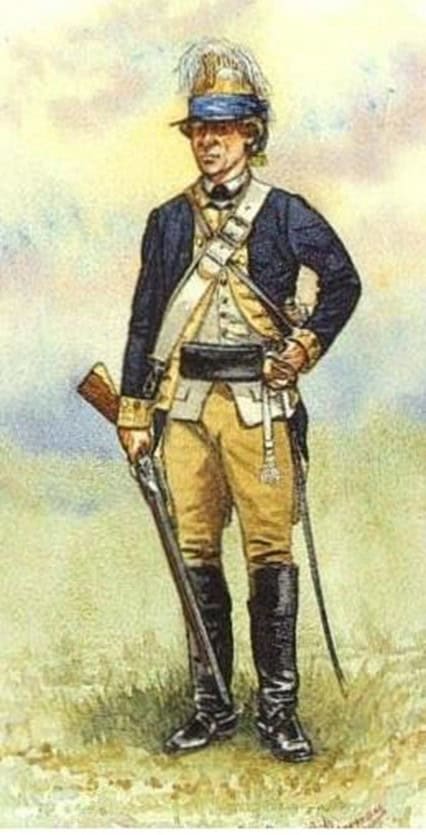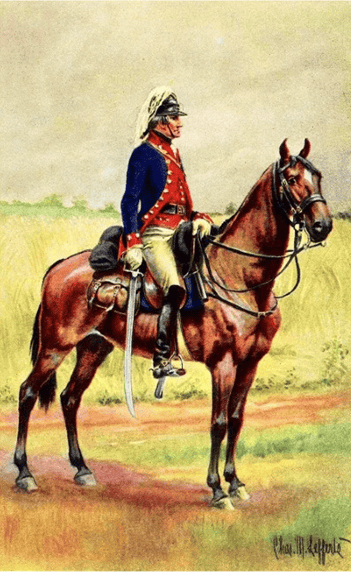
The dragoon units were a versatile bunch. Besides serving in battles, they patrolled, gathered intelligence, served as messengers, and guarded supplies and supply routes. Washington’s Headquarters Guard (or Life Guard) operated out of a dragoon unit, Elisha Sheldon’s 2nd Continental Light Dragoons. Also, the famous the Culper Spy Ring operated out of the same unit, under the leadership of Major Benjamin Talmadge. They even served at sea as whaleboat raiders, capturing British vessels on Long Island sound.
The word dragoon derives from the French word for dragon, dragón. This was a nickname for their weapon, the carbine or short musket, called “the dragon,” which referred to the fire that emits out of the gun when fired. The flint-holding jaws of some more ornate muskets were even cast as dragon heads.
During the Revolution there were four dragoon regiments of the Continental Army, the largest of which being Sheldon’s Light Dragoons, which at its peak had a roster of 416 men.
The dragoon uniform and equipment was uniquely designed for their multifunctional role. Most distinctive was their helmet, a brass structure covered with bearskin or leather, with an attached horse hair crest. The brass provided greater protection against sword blows. The horse hair not only denoted cavalry, but also provided special protection because the horse hair is slick and hard to cut, so that sword strikes were more likely to slip over the helmet and off the back of the head. The helmets were quite advanced in design, including a special raised center crest which acted as a “crumple zone” and an internal suspension system similar to today’s modern military and sports helmets.
Their pants were deerskin leather riding breeches with white knee guards, and their regimental jacket was short to facilitate riding. They wore black leather knee-high riding boots and spurs. They would carry with them a sling to hold their musket, a cartridge box buckled around their waist like a modern-day fanny pack, and a double carriage to hold both their sword and bayonet. Their swords were perhaps the most important weapon of a dragoon, but they were not sharp and were not meant for stabbing or cutting. Rather, they were meant to be swung against an opponent to inflict blunt force trauma injuries. Often a dragoon also carried a pistol or blunderbuss (an early version of a shotgun). While on horseback, behind their saddle they would carry their portmanteau (suitcase), bedroll, and other supplies in saddle bags.
Dragoon units existed in the army until 1861, when all mounted units (cavalry, mounted riflemen, and dragoons) were all redesignated as cavalry, thus ending the era of the dragoon.
We salute the Revolutionary dragoons from Morris County: David Bedell, John Blowers, Alexander Carmichael, Moses Day, Elisha Drake, Daniel Jackson, Joseph Johnson, Joseph Ludlow, George O’Hara, Samuel Roome, Recompence Stanbury, Jeremiah Stone, Daniel Vreeland, John Wick, and John Wilkinson.
We also salute our own Dr. Jabez Campfield, who was not a dragoon himself, but served as a regimental surgeon in Sheldon’s 2nd Continental Light Dragoons from 1781 until the army was dissolved at the end of the war.
http://www.dragoons.info/wp-content/uploads/2016/08/2LD_Dragoon_Power_Point.pdf


Sources
Schenawolf, Harry, “American Light Dragoons and Partisan Corps in the Revolutionary War, Revolutionary War Journal, 5 March 2019, online at https://www.revolutionarywarjournal.com/american-light-dragoons-and-partisan-corps-in-the-revolutionary-war/
Second Continental Light Dragoons, “History of Sheldons Horse,” online at http://www.dragoons.info/our_past/history_of_sheldons_horse/
Shaw, Travis, “Cavalry in the American Revolution,” American Battlefield Trust, online at https://www.battlefields.org/learn/articles/cavalry-american-revolution
_____, “2nd Continental Light Dragooons” on wikipedia.com, online at https://en.m.wikipedia.org/wiki/2nd_Continental_Light_Dragoons
_____, “Dragoon Soldier: Historical Background,” Fort Scott National Historic Site, online at https://www.nps.gov/fosc/learn/education/dragoon5.htm
Morristown ChapterDaughters of the American Revolution